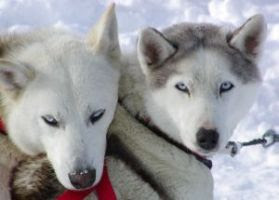
By Ruthie Bently
If you discover that your dog has an injury, try to stay as calm as you can. By staying calm you can keep your dog calm as well. They can sense your stress, and the most important thing is to keep them calm. The next thing to do is to determine where the blood is coming from. For example, a dog can cut their paw and it may bleed profusely, though it may not be a serious injury. Check them all over from nose to tail to find out where they are bleeding. By finding the source of the bleeding, you can determine how serious the wound is and proceed from there.
The color of the blood can help you determine if it comes from an artery or a vein. Venous blood will be a dark red color and may ooze from a wound, and arterial blood will be bright red because of its oxygen content. If there is a lot of blood and the wound has stopped bleeding and begun to clot, do not attempt to remove the clot, as this can make the wound begin to bleed again. Wrap the wound in a clean towel or several layers of gauze and tape the wound well but not too tightly, as this can cause swelling in the affected area. This is called a pressure bandage.
If the bleeding is severe and you can’t get the wound to stop bleeding or it is bleeding sluggishly, again apply a pressure bandage and get your dog to the vet or emergency clinic as soon as you can. This situation can be life threatening and time is of the essence. Another way to stop the bleeding is to use a tourniquet, but do not use this method unless advised by your veterinarian, because cutting off the blood flow completely can damage tissue in the surrounding area.
If it is a cut on your dog’s foot, it could be from a foreign object they stepped on outside. The capillaries in a dog’s foot are very close to the surface and they can bleed profusely even if the wound is minor. Carefully examine their foot to find the source of the bleeding. If you don’t see a foreign body lodged in their foot and the bleeding is minimal you can clean it with a mixture of 50% hydrogen peroxide and 50% water. If it is the webbed tissue between their pads, it may not stop on its own and may require stitches.
The most important things about a cut on your dog are to get the bleeding stopped and prevent infection. If the cut is a laceration of an inch or more and has any amount of depth to it, it may require stitches. Any cut may become infected, and you should contact your vet about using an antibiotic to keep infection at bay.
My AmStaff, Skye, had an accident that happened when she walked through a broken glass jar one of the cats had knocked off my kitchen shelf. She nicked her right leg, which required two stitches. Her left leg was a more serious injury. She cut the ulnar artery (one of the two in her leg) and cut through two tendons, and the blood was bright red. I don’t tell you this to scare you or gross you out; I just want you to be aware that no matter how careful you are in your own house, accidents can happen when you least expect them, and you need to be prepared.
Because of my quick action, the vet’s prognosis of her regaining the full use of her leg and foot are good. We have a first aid kit for our animals, as every responsible pet owner should. If you want to make one, read Linda Cole’s June article for a list of basic first aid supplies.
Read more articles by Ruthie Bently
























